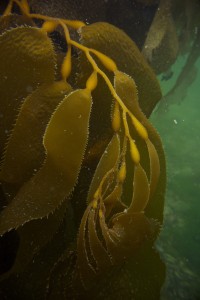Monday started with the usual lab work, but this time with the copper rockfish. We did our morning round of fish feeding and temperature monitoring, and it seems that the experiment was off to a good start! In the afternoon, Katie and Sara had reserved a boat to go out to their collection sites and gather the “smurfs” – a bundle of plastic webbing that they drop down a weighted line and acts as artificial habitat for the juvenile rockfish to congregate on. In addition to pulling up the smurf nets, Katie and Sara were collecting any other juvenile rockfish to euthanize for DNA/RNA samples. It was a fun day out on the boat and we were able to get all 6 nets collected in the 2-hour time slot. By the time we got back to the dock, offloaded all the gear, rinsed and put things away, it was late afternoon and we swung back to the lab to check on the fish. Since it was the beginning of the experiment and buckets had just been refilled from scratch, we wanted to do extra checks on the temperature to make sure they were right around the targets. After dinner it was back to the lab for the official feeding and temperature taking and just like that, Monday was over and I was down to one last week at Bamfield!

Tuesday was a pretty routine day for us – usual lab work in the morning and evening, with not much time for anything else. By this time, though, Sara and I had become good friends with some of the other TAs and researchers at the station so we had been skipping our nightly ritual of sunset watching to hang out with our friends in their cabin, known as Seaside. It was great to meet people who had spent a lot of time out at Bamfield and who are doing a wide variety of research for masters and PhD projects – gave me a chance to learn about pertinent research in the Pacific Northwest as well as make some solid friendships. Tuesday happened to be one of the girl’s last night, so we all had a small good bye party, including lots of popcorn, some drinks, and best of all – a bioluminescence party down at the dock. Bamfield has such little light pollution that when dark finally comes (at 11pm) it gets quite black and the bioluminescence really is apparent. We grab hand nets and paddles and swirl them around in the pitch black water only to have it explode in fireworks – networks of light created by tiny creatures in the water. It’s surreal and beautiful.
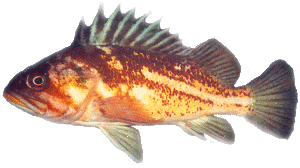
Wednesday came super early, as we were in the lab and working by 6 am. We decided on such an early start because the professor of the marine fishes class invited Sara, Steph, and me on the class field trip to the Great Tidepool that day. This tidepool is claimed to be the biggest in the world, so big and deep you can snorkel in it! So of course we wanted to tag along. After speeding through our lab work, we headed down to the foreshore to meet up with the class and load up on the boats. It was a 25-minute drive or so out to the Broken Island group, when the tidepool was located. After a 10-minute hike through the forest, we reached the tidepool, which sat inbetween lush forest and the rugged coastline. Everyone was eager to jump in, so we all donned our wetsuits, masks, fins, and snorkels and waded in. It was amazing – so much life to be seen in the pool of cold saltwater. I saw crabs, seastars, sculpins, anemones, flatfish, nudibranchs, kelp, moon snails, and so much more. The tidepool was so vast that after snorkeling for an hour I hadn’t seen the entire pool. But the cold had started to bite at my feet so I hopped out to warm back up and wander around the rocky shoreline. After warming up, eating lunch, and chatting with the students, Sara and I decided to hop back in for another snorkel to cover a nice kelp bed we hadn’t explored yet. After another 30 minutes or so I hopped out (cold again!) and set to warm back up and take some photos around the tidepool. By mid-afternoon, we had started the forest hike back to the boats and loaded up to head back to the station. Upon getting back, Sara and I did a quick check on the little fishies in her experiment, then off to shower and eat dinner. The evening concluded with the usual lab work and then some hanging out in Seaside with the other TAs.
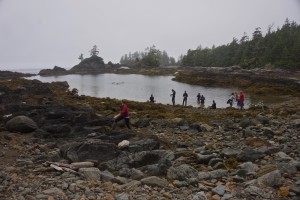
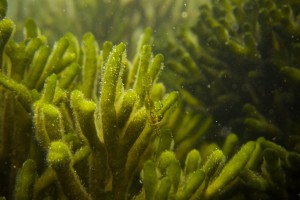
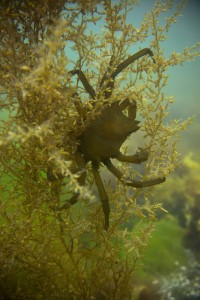
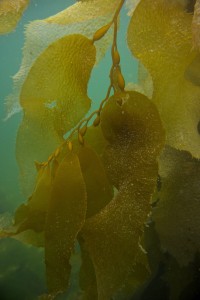
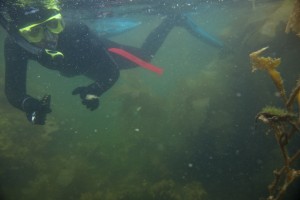
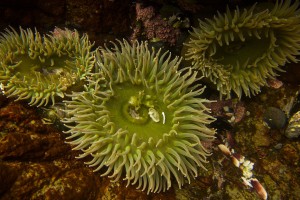
Thursday cruised by just like any other day – lab work for most of the day, with hanging out and socializing at Seaside in the evening. The experiment with the copper rockfish had started to gain some differences from the experiment with the black rockfish. With the blacks, we were constantly struggling to maintain the target temperatures in each bucket, but very few of the fish died during the course of the experiment. With the coppers, the temperatures were much closer to the target goals but fish were dying off like crazy! For a while, Sara suspected it was ash in the water that was being used to feed the fish, but we ruled that idea out by examining a water sample under a microscope. The increased death rate was certainly interesting, and will provide some good data for Sara to work through at the end of her experiment. In the meantime, the fires on the island had cast Bamfield in clouds/overcast skies for the past 5 days so no need to watch the sunset after our evening lab work, as they were drab and grey these days.
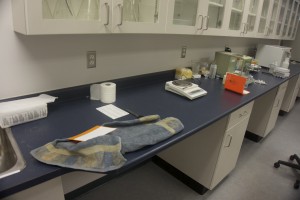
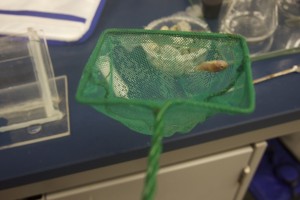
Friday was another busy yet fun day. Sara wanted to clean all the buckets as well as measure/weigh all the fish. Unfortunately quite a few had died off by this time, but it did mean less work for us. We set up the measuring/weighing station and started at it! By this time, it was our third round of cleaning buckets, so we had an efficient system down and were flying through the copper rockfish. We finished right around 1, and I dashed from the lab down to the foreshore, as I had been invited to tag along on a trip to trawl for the marine fishes class. I barely made it in time to join the group and we headed out to a deep portion of the channel, where we could drop the nets quite deep. Some students from the class needed to collect dogfish, ratfish, and flatfish for research projects, so fingers were crossed as we dropped the nets into the water and began to trawl. After a nice, long trawl for about 40 minutes, we began reeling in the net and dumped the catch into the sorting table on the back deck of the boat. Man oh man did we catch some fish! We had tons of flatfish and ratfish, and even one dogfish! Plus all sorts of eelpouts and shrimps and even a few stubby squids in the mix. We sorted through all the fish, setting aside the ratfish, flatfish, and dogfish in buckets for the research projects and throwing back any other live fish into the sea. Once all the fish had been sorted and either put in a bucket or thrown back into the ocean, we headed back to the station. It was a fun afternoon and gave me the chance to learn more PNW fish species. This evening, instead of helping in the lab, I went down to the NOVA Harvest hatchery for their open house and BBQ. NOVA Harvest is a local aquaculture business seeding geoducks to ship out for commercial purposes and they are located on the research station. They hosted an open house for all TAs/researchers to come and learn more about the business and how the geoducks are raised from spawning to tiny little clams that are shipped out. It was really interesting to learn about this industry, which I had no previous knowledge of (but would also help prep me for my upcoming time with Julie Barber and her geoduck surveys in Washington!).
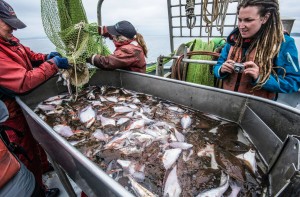
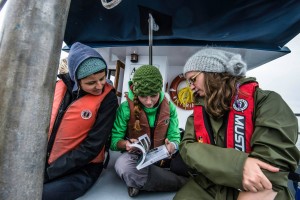
Saturday I had made plans to go camping with Chad, the assistant DSO, but the persistent rain the whole day made us rethink our plans. After helping with the morning lab work, we decided to instead do a long hike to one of the nearby beaches as a good compromise. We grabbed some snacks at the local market and drove to the trailhead, where we began a muddy but adventurous hike to Topaltos Beach. It was about 3.5 kilometers through underbrush and muddy trails to get to the beach, but most definitely worth the trek. It was an isolated beach that stretched along the coast – the ideal image of the Pacific Northwest. We tried to push further up the trail to a second beach, Cape Beale, but the path was overgrown with salal bushes that made going any further a long and arduous task, so we turned round and hiked back past Topaltos 1.5 km toward the trailhead, where the trail splits into two paths – one towards Topaltos (which we first took) and one towards Keeha beach – and we headed towards Keeha. This is a popular beach, but the trail is full of mudholes and tree roots, so we plodded forward in the misting rain. After another 1.5 km or so, we made it to Keeha, another beautiful beach stretch. After taking some pictures and having a few snacks, we turned back towards the trailhead, as the day was getting late and light was slowly fading. After another hour of hiking, we made the 3.5 km back to the truck. Both of us were thoroughly soaked through and covered in mud from the knees down, but it had been such a nice day of hiking. We drove back to the station to take hot showers and eat a nice warm dinner, before back to the lab to help Sara. Even though my camp trip didn’t work out, the hike was such an enjoyable substitute and a great way to spend my last Saturday at Bamfield.

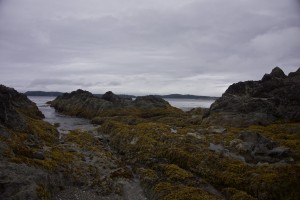
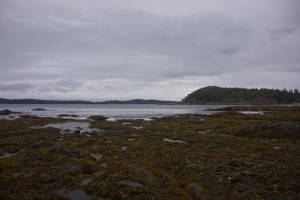

Sunday morning broke with glimpses of the blue sky, which was exciting for us all, as we had nothing but grey skies for the past week. The blue skies came and went throughout the day, but the sight of blue lifted everyone’s spirits for the day. I had finished another adventurous week out at Bamfield, and found myself falling in love with the rugged Pacific Northwest. Too bad my time was rapidly coming to an end and I was soon to be on to my next adventure.
